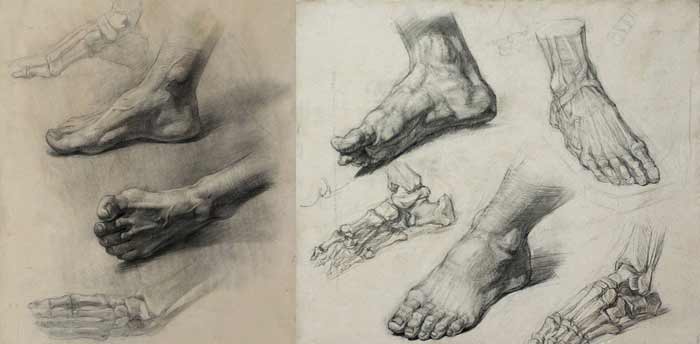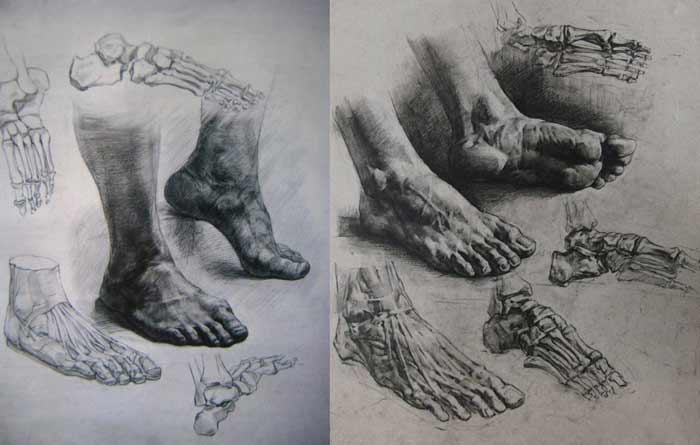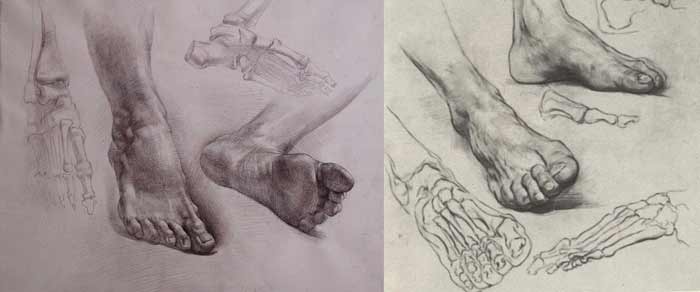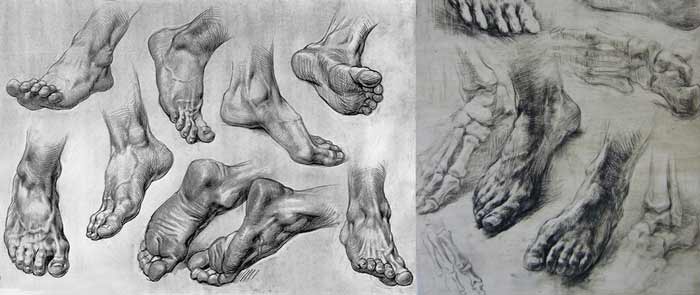Foot Anatomy
Foot Anatomy
Anatomy Lesson 13
In this video lesson, you will discover the foot anatomy.
Foot Anatomy – Proportions
When drawing the foot anatomy, there are some proportion rules you need to remember. The length of the foot (from the tip of the toes to the heel) is equal to the height of the head (from the top of the cranium to the bottom of the chin).
Remember, the width of the foot can be divided into three equal parts. The great toe occupies one part, or one-third, of the foot’s width.
Even though the great toe is the largest, it has only two phalanges. All other toes have three.
The foot has three main points where it touches the ground. The main point of support is the heel bone. There are two more important points, that together with the heel bone, make the triangle of the foot. These points are where the great toe and the little toe are attached to the foot.
A human foot is arched. This is to absorb shocks from body weight when walking, running, and jumping. However, the foot is not equally arched. The inner arch is much higher than the outer one. You also need to know that there is another arch that goes across the foot. These arches absorb body weight pressure and distribute its weight during movement.






Foot Anatomy – Bones
There are twenty-six bones of the foot. They include seven tarsal bones, five metatarsal bones, and fourteen phalanges of the toes.
In some ways, the skeletal anatomy of the foot resembles the anatomy of the hand.
The tarsal bones can be compared to the bones of the wrist, the metatarsal bones are comparable to the five metacarpal bones, and the fourteen phalanges of the toes are equivalent to the fourteen phalanges of the fingers and thumb.
There is also similarity between the thumb and great toe. They both have only two phalanges. However, the fingers and the lesser toes each have three phalanges.
At the back of the foot, there are two tarsal bones which worth mentioning.
The heel bone and the bone which is placed above it, which has a semi-cylindrical smooth shape at the top.
Making the ankle joint, this smooth shape connects with the lower leg bones. This joint works like a hinge allowing flexion of the foot upward and downward.
The great toe and the second toe are the longest in the foot. Two phalanges of the great toe are the thickest.
The first phalange of the great toe points slightly upward. This direction changes downward in the second phalange which ends with a shape that resembles an animal’s hoof.
The phalanges of the lesser toes are much shorter than the phalanges of the fingers.
Unlike a thumb, the greater toe points in the same direction as the lesser toes.
The phalanges of the third, fourth, and fifth toes are slightly curved down when the foot is relaxed.
To make sure that the great toe is connected to the foot in a realistic manner, you can use the following method.
At the end of the first metatarsal bone, which is the thickest, draw a circle which represents the joint between this metatarsal bone and the first phalange of the great toe. This circle is the base of the cylinder which inscribes the first half of the great toe.
Foot Anatomy – Muscles
The Achilles tendon of the calf muscle inserts into the heel bone.
Along the inside margin of the foot, there is the muscle which is attached to the heel bone and goes along the inner arch of the foot and inserts into the great toe. Its main function is to pull the great toe away from other toes.
Along the plantar side of the foot, there is another muscle that connects the heel bone with four lesser toes. When contracted, it flexes these toes…
[ The full lesson is avaibale to Anatomy Master Class members ]
To learn more about the foot anatomy, enroll in the Anatomy Master Class
Simple Pricing, No Surprises
One-time payment - Only $97 USD
ENROLL NOW



